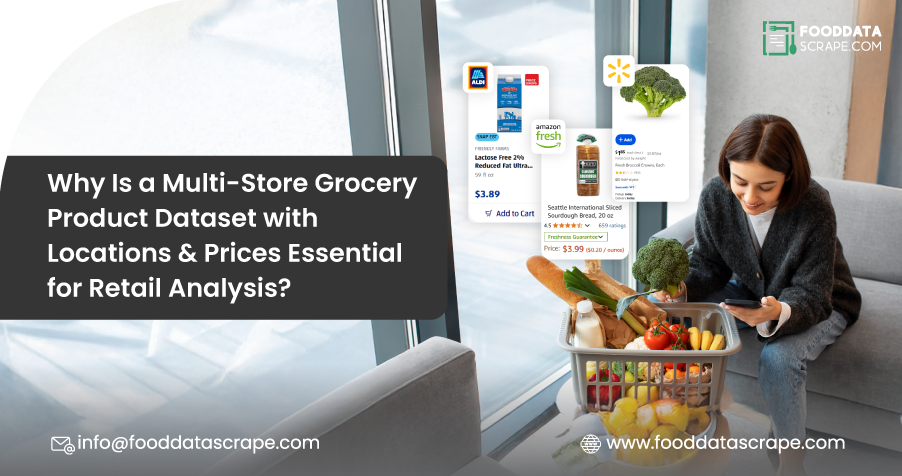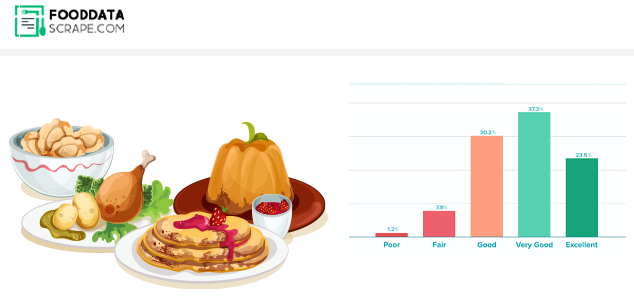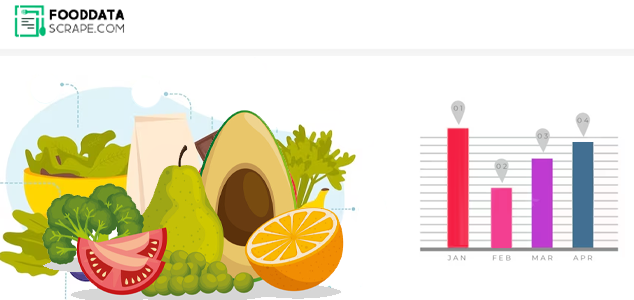Introduction
Grocery data has become a vital resource for retailers, manufacturers, and analysts in today’s real-time commerce world. Understanding the shifting consumer preferences, dynamic pricing, and localized inventory situations is a huge advantage in such a competitive environment. An organized Multi-Store Grocery Product Dataset with Locations & Prices tells us much more than if an item is in-stock; in combination with the other datasets, you discover how shoppers are doing things, with grocery data changing how people think about a grocery store. The different fields in Grocery datasets, such as product name, department, price, and store location (address), are critical to understanding these behaviors. When you Extract Walmart, Aldi & Amazon Grocery Product Data, not only do you get to see how prices differ across regions, but you get to see their promo strategies and any inventory assortment differences across formats. A comprehensive Grocery Store Datasets with Store Locations & Prices allows your team to competitively benchmark, regionally optimize SKU's & make significant merchandising decisions. It's not just data, it's Grocery Intelligence that leads to operational decision-making on digital shelves or in physical retail.
Why Walmart, Aldi, and Amazon?
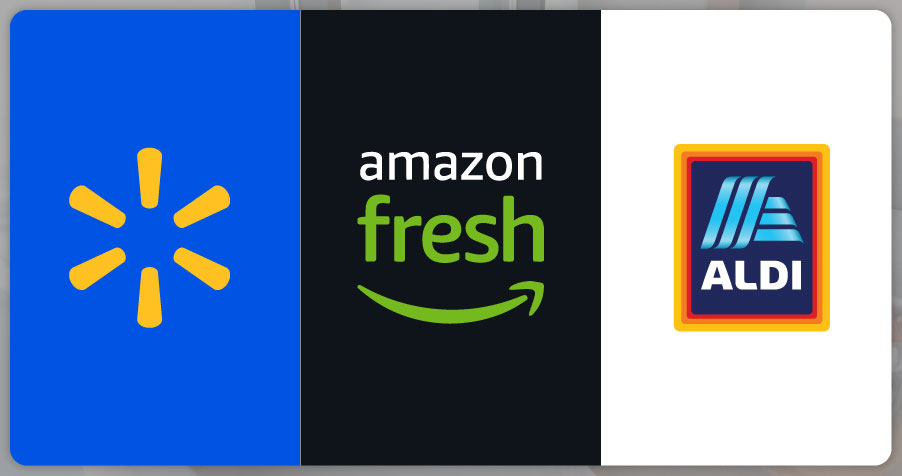
These three giants represent diverse approaches to grocery retailing:
- Walmart: The largest brick-and-mortar grocer in the U.S., with a vast physical and online footprint, catering to nearly every demographic.
- Aldi: A fast-growing discount grocery chain known for private-label goods, limited assortment, and regionalized store strategies.
- Amazon: A tech-driven platform leading the charge in online grocery retail with expansive product variety, including Amazon Fresh and Whole Foods integrations.
- Each of these platforms—Walmart, Aldi, and Amazon—offers : distinct value in the grocery ecosystem. Extracting structured data fields, such as store location (address), product name, price, and department, provides businesses with a clear, multidimensional view of modern grocery competition. By leveraging Grocery Pricing Data Intelligence, companies can analyze pricing patterns, promotional strategies, and regional assortments across both digital and physical formats. These insights, when drawn from robust Grocery Store Datasets, empower data-driven decisions in merchandising, pricing optimization, and strategic inventory planning across diverse retail environments.
The Value of Extracted Grocery Product Data Fields
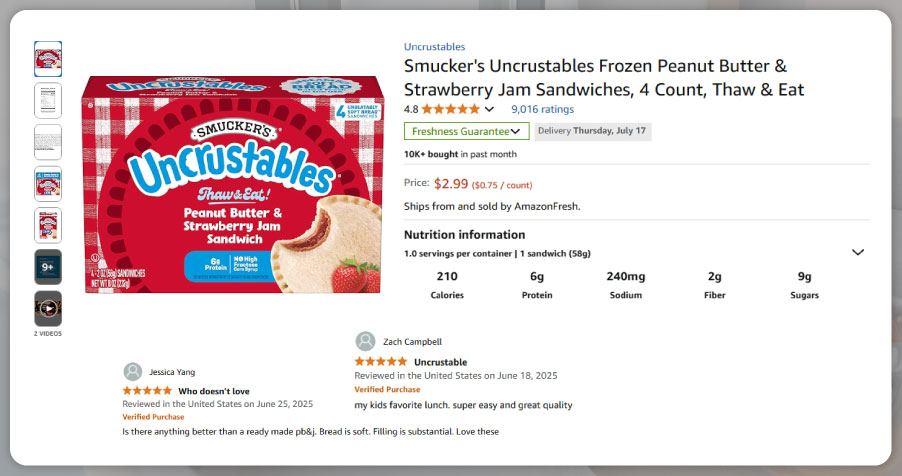
1. Product Name: The name of a product provides more than just identification—it reveals brand positioning, size or weight variations, ingredient callouts, and health or lifestyle claims (e.g., organic, keto, gluten-free). For example:
- Great Value Organic Baby Spinach, 5 oz
- Simply Nature Cage Free Large Brown Eggs
- 365 by Whole Foods Market Unsweetened Almond Milk
By collecting product names from Walmart, Aldi, and Amazon, analysts can assess brand strategies, frequency of private-label entries, and keyword usage across various formats. Product naming conventions also inform NLP models used for item classification and comparison across retailers.
2. Department: Departments serve as categorical anchors that reveal how retailers structure their inventory and how customers navigate them. The same product may be listed under different departments, depending on the store's marketing strategy.
- Walmart might classify "Greek Yogurt" under Dairy & Eggs
- Aldi may place it under Chilled Foods
- Amazon could associate it with Pantry or Health & Wellness
By extracting department data, businesses can map category density, identify assortment gaps, and monitor which departments are growing in size or diversity across each retailer.
3. Price: Price is arguably the most dynamic field in grocery data. Prices fluctuate based on promotions, store location, brand strategy, and online competition. By collecting price points across Walmart, Aldi, and Amazon, one can:
- Benchmark private-label vs. national brand pricing
- Track promotional cycles and discount depths
- Analyze regional price variations
- Identify price leadership and parity strategies
Price analytics becomes even more powerful when paired with product_name and department data to calculate price per ounce, serving size value, or multi-pack savings.
4. Store Location (Address): This is the geographical anchor to all other data fields. By extracting the store location (address) of each listed item (especially for Walmart and Aldi), businesses can connect product data with:
- Local pricing strategies
- Regional assortment variations
- Competitor stocking behaviors
- Market-level supply chain modeling
For example, a pack of grass-fed beef might be available at a Walmart store in Austin, Texas, but not in a rural area of Arkansas. Aldi's private-label gluten-free snacks may be stocked only in urban stores with higher dietary demand. Even Amazon differentiates products by ZIP code availability through fulfillment center logic. Using tools like a Grocery Price Dashboard, analysts can visualize regional price spreads. A Grocery Price Tracking Dashboard enables brands to monitor real-time fluctuations based on location and fulfillment model, fueling more innovative inventory planning and hyper-local pricing decisions.
Extracted Grocery Product Fields
| Store | Product_Name | Department | Price (USD) | Store_Location (Address) |
|---|---|---|---|---|
| Walmart | Great Value Whole Milk, 1 Gallon | Dairy & Eggs | 3.27 | 123 Main St, Dallas, TX 75201 |
| Aldi | Simply Nature Organic Bananas, 2 lb | Produce | 1.49 | 475 Oak Rd, Columbus, OH 43215 |
| Amazon | 365 Everyday Value Organic Black Beans, 15 oz | Pantry | 1.19 | Online – ZIP: 90001 (Fulfilled by Amazon Fresh) |
| Walmart | Equate Daily Fiber Powder, 48.6 oz | Health & Wellness | 10.98 | 980 Retail Pkwy, San Antonio, TX 78258 |
| Aldi | Friendly Farms Vanilla Greek Yogurt, 32 oz | Chilled Foods | 3.79 | 1055 Market Dr, Minneapolis, MN 55401 |
| Amazon | KIND Bars, Dark Chocolate Nuts & Sea Salt, 12 ct | Snacks | 14.99 | Online – ZIP: 30301 (Prime Pantry) |
This table demonstrates how diverse and powerful extracted grocery data can be when all key fields—product name, department, price, and store location—are captured and structured for analysis.
Extract real-time grocery data from Walmart, Aldi, and Amazon to fuel your next big move.
Applications of Extracted Walmart, Aldi & Amazon Grocery Data
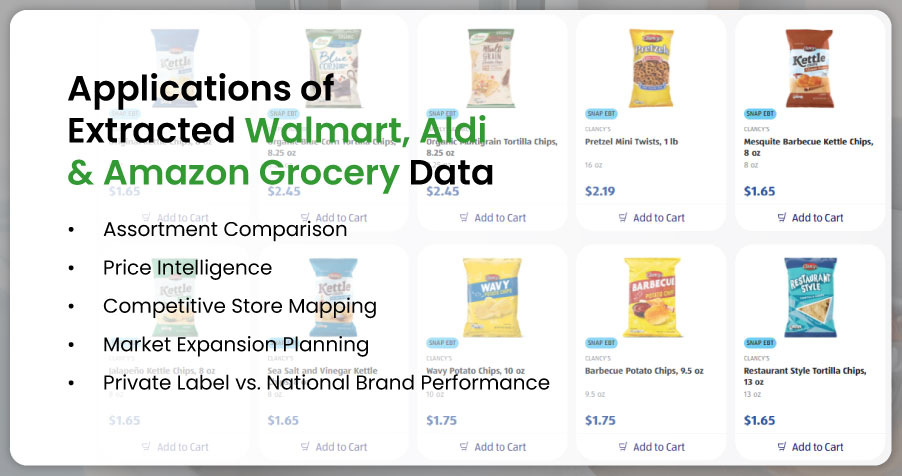
Extracted grocery data from Walmart, Aldi, and Amazon offers powerful applications in pricing intelligence, product trend analysis, inventory planning, and competitive benchmarking. Retailers and analysts use this data to optimize strategies, improve customer experience, and track market shifts effectively.
- Assortment Comparison: Retailers and manufacturers can use Grocery Store Location and Pricing Data Scraping to analyze which products are listed where, identifying regional gaps or overlapping SKUs. For instance, if a high-performing item is on Amazon and Aldi but absent from Walmart, that signals a potential white space opportunity.
- Price Intelligence: Using tools that Scrape Real-Time Grocery Pricing from Top Supermarkets, brands can adjust MSRP based on dynamic market conditions. For example, if Aldi consistently prices its organic pasta 20% lower than Amazon’s cheapest SKU, it can inform promotions and regional pricing strategies.
- Competitive Store Mapping: Store-level address data enables retailers to compare formats like Walmart Supercenters vs. Aldi neighborhood stores using insights from the Walmart Grocery Delivery Scraping API and Aldi Grocery Delivery Scraping API. This helps tailor local displays, inventory, and promotions.
- Market Expansion Planning: With the Amazon Fresh Grocery Delivery Scraping API, retailers and suppliers can track product availability across ZIP codes, identifying underserved regions for strategic SKU launches or store openings.
- Private Label vs. National Brand Performance: Using structured data on product_name and department, brands can compare private-label penetration (e.g., Great Value, Simply Nature) against national brands across categories like dairy and snacks, evaluating pricing and placement across all three retailers.
Department-Level Insights: What the Data Reveals
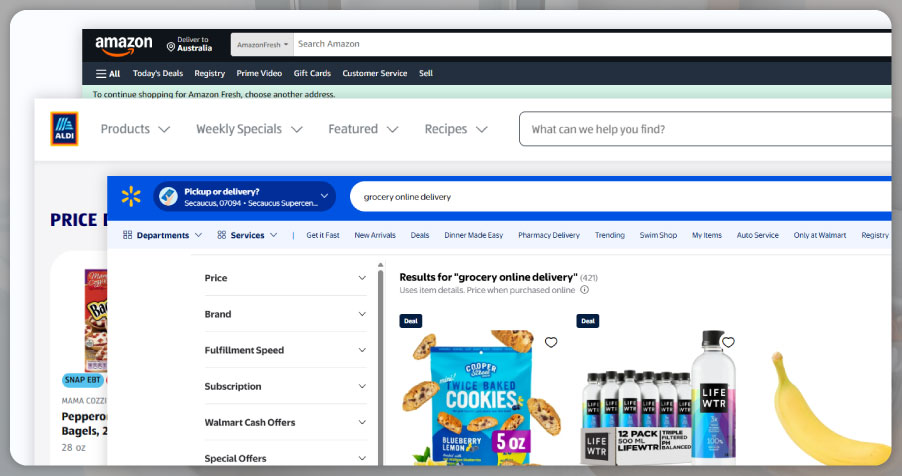
When analyzing department data across Walmart, Aldi, and Amazon, several interesting patterns emerge:
- Walmart focuses heavily on breadth, often listing the same product across multiple sub-departments.
- Aldi emphasizes core food essentials, with fewer departments but highly curated assortments.
- Amazon blends food with lifestyle categories, often mixing pantry goods with wellness or subscription models (like Subscribe & Save).
This matters when designing promotional campaigns or planning cross-channel expansions. If a plant-based protein bar is in Snacks at Aldi but under Fitness Nutrition on Amazon, marketers must tailor messaging accordingly.
Real-Time Grocery Intelligence: The Strategic Edge
Today’s competitive edge isn’t just about having products on shelves—it’s about knowing what’s selling, where, at what price, and how often. When you Extract Walmart, Aldi & Amazon Grocery Product Data with structured fields like product_name, department, price, and store_location (address), you gain a dynamic framework to:
- Monitor competitors at SKU and store level
- Adjust pricing strategies dynamically by region
- Benchmark against private-label performance
- Customize inventory planning based on regional demand
- Inform predictive analytics models for demand planning
How Food Data Scrape Can Help You?
- Retailers Seek Hyperlocal Insights: With store-level data including pricing and product availability, our scraping solutions help businesses tailor offerings to specific regions and consumer demographics.
- Real-Time Competitive Intelligence: Brands and analysts rely on our tools to monitor pricing and assortment across Walmart, Aldi, and Amazon in real time, enabling faster strategic responses.
- Rising Demand for Clean, Structured Data: Our ability to deliver high-quality, normalized Grocery Store Datasets gives companies a trusted foundation for market analysis and decision-making.
- Fueling AI and Predictive Models: Our scraped data supports advanced analytics, including Grocery Pricing Data Intelligence, trend forecasting, and demand prediction across departments and geographies.
- Cross-Platform Visibility: As omnichannel retail grows, our multi-store scraping (covering physical locations and e-commerce) ensures businesses have a unified view of grocery market dynamics.
Final Thoughts
In a market where grocery buying behavior is influenced by local trends, digital convenience, and pricing pressure, the need for accurate, real-time, store-level grocery data has never been greater. Walmart, Aldi, and Amazon represent three of the most important nodes in this ecosystem—spanning physical stores, online platforms, and hybrid fulfillment models. Leveraging Grocery App Data Scraping Services allows businesses to track shifting demand, promotions, and inventory availability across these networks.
By extracting key data fields such as product name, department, price, and store location (address) from these platforms, businesses unlock unmatched visibility into grocery retail. Through Web Scraping Quick Commerce Data and robust Grocery Delivery Scraping API Services, teams can access structured datasets that drive competitive benchmarking, regional assortment optimization, and responsive pricing strategies. Whether you're a retailer optimizing assortment, a brand adjusting pricing, or an analyst benchmarking performance—this data is your foundation for faster, smarter decision-making in the grocery economy.
Are you in need of high-class scraping services? Food Data Scrape should be your first point of call. We are undoubtedly the best in Food Data Aggregator and Mobile Grocery App Scraping service and we render impeccable data insights and analytics for strategic decision-making. With a legacy of excellence as our backbone, we help companies become data-driven, fueling their development. Please take advantage of our tailored solutions that will add value to your business. Contact us today to unlock the value of your data.






















































































